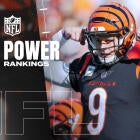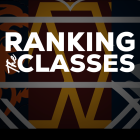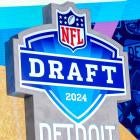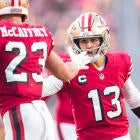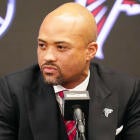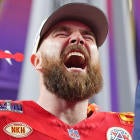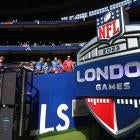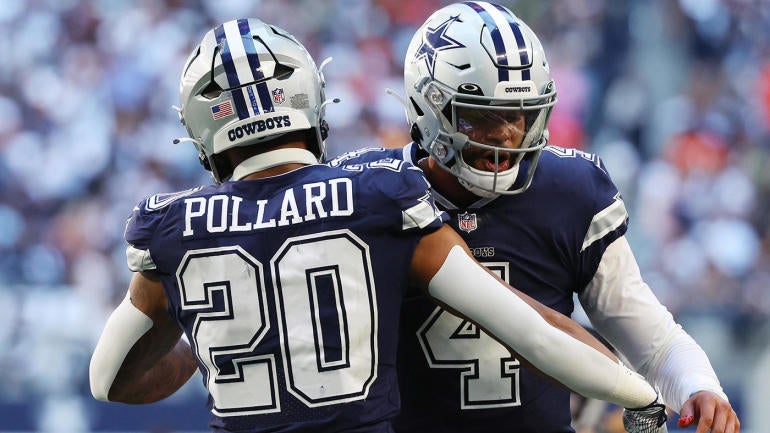
The NFC was the 49ers invitational this season, even though San Francisco was challenged in the postseason. The 49ers had the best record in the conference and stomped their two biggest challengers in the regular season (Philadelphia Eagles and Dallas Cowboys), but struggled to beat the Detroit Lions and Green Bay Packers in the playoffs en route to the Super Bowl.
Repeating as NFC champions is extremely difficult, as the feat hasn't been accomplished since the Seattle Seahawks in 2013 and 2014. The losing NFC team in the Super Bowl hasn't repeated as a conference champion since the Minnesota Vikings in 1973 and 1974. That's the challenge the 49ers face in 2024.
Right on the 49ers' heels are the Lions and Packers. The Cowboys and Eagles should also be in the mix for the conference title, while the Los Angeles Rams will look to play a factor in the race. There's always a surprise team or two that emerges from the shadows. Will that be the Chicago Bears, Tampa Bay Buccaneers, Seattle Seahawks or another team?
With free agency and the new league year right around the corner, here's what every NFC team needs to improve upon in order to compete for the conference title.
Note: Salary cap figures courtesy of Over The Cap.
Arizona Cardinals
- Needs: CB, DT, EDGE, LB, OG, WR
- Projected cap space: $41,715,463
The Cardinals are going to need significant help on defense if they are going to be competitive in 2024. Arizona was 29th in the league in points per play allowed (5.7), 32nd in rush yards allowed (143.2), 32nd in third-down defense (47.3%), and 30th in sacks (33).
Arizona could use a proven pass rusher for defensive coordinator Nick Rallis, helping Jonathan Gannon's scheme thrive (see Haason Reddick with Eagles in 2022). The Cardinals could also use help on the defensive interior too, a full revamp on the defensive line. Getting a proven pass rusher and a good defensive tackle is massive for Arizona's offseason.
The Cardinals also need a No. 1 wide receiver for Kyler Murray. Holding the No. 4 pick could land Arizona Marvin Harrison Jr., but the Cardinals could get deeper at the position on the free agent market. One problem? The free agent class at wide reciever isn't deep.
Defense can be addressed in free agency. Offense through the draft.
Atlanta Falcons
- Needs: QB, LB, WR, EDGE, CB, S
- Projected cap space: $25,849,508
Same old story for the Falcons. Atlanta is a competitive football team that fights deep into December in the weak NFC South, but falls short due to not having a competent quarterback. The Desmond Ridder experiment didn't work and Taylor Heinicke wasn't any better. The Falcons need to find a good starting quarterback in free agency or develop a quarterback by using their first- or second-round pick on one.
Atlanta isn't a playoff team without a quality starting quarterback. The Falcons could also use a solid No. 2 wide receiver next to Drake London to help that quarterback as well. The defense was improved last season, but will be revamped with Ryan Nielsen gone.
The Falcons need more help rushing the passer, especially with Calais Campbell and Bud Dupree both free agents. They could use a consistent force off the edge next to Arnold Ebiketie.
Carolina Panthers
- Needs: WR, RB, OG, OT, CB, DT, EDGE
- Projected cap space: $28,599,402
If Bryce Young is going to succeed in Carolina, the Panthers have to provide help around him. Young was 31st in completion rate (59.8%), 31st in touchdown rate (2.1%), 32nd in success rate (36.5%), 32nd in yards per attempt (5.5%), and 32nd in passer rating (73.7) among 32 qualified quarterbacks.
Young had Adam Thielen get 1,000 yards last season, but no other pass catcher had over 600 yards. The Panthers had two tight ends who combined for 378 yards, so there was little help in the middle of the field.
The offensive line was also a disaster from the first preseason game on. Carolina allowed 65 sacks (31st in NFL) and had a pressure rate allowed per dropback of 41.1% (29th in NFL), having Young run for his life throughout the year. The Panthers need to see if Young can play, but they also have to provide players good enough to help him out.
Chicago Bears
- Needs: OG, C, EDGE, DT, WR
- Projected cap space: $66,996,157
The Bears' offseason comes down to what they intend to do with Justin Fields and the No. 1 overall pick. Does Chicago move on from Fields and use the No. 1 pick on a quarterback? Do the Bears trade the No. 1 overall pick again and get a massive haul for the pick for a second consecutive year?
With Shane Waldron aboard as offensive coordinator, does he want to move forward with his own quarterback? The Bears can still get draft capital for Fields and use the massive cap space to improve the interior of the offensive line. They also need to re-sign cornerback Jaylon Johnson and keep him in the fold.
Montez Sweat was a major addition for the Bears at the deadline last year. Getting Sweat an extra edge rusher or an interior rusher to help him out wouldn't hurt either.
Dallas Cowboys
- Needs: C, RB, CB, DT, OG
- Projected cap space: -$19,740,700
The looming Dak Prescott decision awaits in Dallas. Prescott carries a $59.46 million cap hit next season, so he has the Cowboys in a bind. An extension of up to $60 million a year could be in play, but Dallas could save $26.2 million in cap space with an extension.
There's also the pending free agent decisions of Tony Pollard, Jayron Kearse and Stephon Gilmore. Can the Cowboys keep any of them? Dallas could also allocate some free agent money at defensive tackle, but risk losing key pieces in the secondary as a result. Micah Parsons is also due for an extension soon.
This critical offseason starts with Prescott.
Detroit Lions
- Needs: CB, OG, DT, EDGE, WR
- Projected cap space: $44,843,386
The most crucial offseason in three decades starts in Detroit. The Lions are Super Bowl contenders in the NFC, but what can Detroit do to get over the hump? The Lions will have to address a secondary in which C.J. Gardner-Johnson and Emmanuel Moseley are free agents. They also lost some safety depth by releasing Tracy Walker.
The Lions were 31st in yards per attempt against (7.8) and 27th in pass touchdowns allowed (28). In addition to revamping the secondary, the Lions could use an interior pass rusher to help out Aidan Hutchinson. Guards Jonah Jackson and Graham Glasgow are also free agents.
If the Lions fix their secondary issues, they could be the top team in the NFC heading into 2024.
Green Bay Packers
- Needs: S, OG, C, EDGE, RB, QB
- Projected cap space: $2,857,641
The Packers were the youngest team since the 1970 merger to win a playoff game, so where do they go from here? Green Bay appears set at the skill positions, even though the Packers will likely lose A.J. Dillon in free agency. Jon Runyan Jr. could also be on the move and David Bakhtiari could be a cap casualty, so a slight revamp of the offensive line could be in order.
Green Bay will have to address a defense that was 20th in yards per play (5.4) and 25th in third-down situations (41.1%). The safety position could use a revamp with Rudy Ford and Darnell Savage hitting the open market, with a top-heavy free agent class.
The defense has to be revamped with new DC Jeff Hafley, but the Packers will have to get creative in improving the unit.
Los Angeles Rams
- Needs: OT, RB, CB, S, EDGE
- Projected cap space: $27,699,574
Another team that could use a revamp in the secondary, the Rams could afford to part with Ahkello Witherspoon and John Johnson. Los Angeles could address this in the draft with five picks in the first five rounds (including the first round).
The Rams will need to find a tight end with Tyler Higbee's knee injury and add some more depth at tackle. They also have to decide if Carson Wentz is good enough to be the No. 2 quarterback to Matthew Stafford another season and find a No. 2 running back to Kyren Williams.
Good signings to add depth at certain positions could transform the Rams from good to great.
Minnesota Vikings
- Needs: QB, EDGE, CB, DT, RB
- Projected cap space: $24,658,132
The Vikings are going to have to decide whether they want to retain Kirk Cousins or not. Minnesota doesn't have a quarterback in the pipeline to start if the Vikings decide to move on from Cousins, yet could get creative with the No. 11 pick and attempt to find a franchise quarterback there (or trade up for the quarterback they want).
Cousins is who Justin Jefferson appears to want as his quarterback, and keeping Jefferson happy is paramount as extension talks persist. Perhaps Minnesota keeps Cousins for one year and grooms his successor. The Vikings are going to have to move on from Cousins at some point and rebuild. Perhaps that time is now with all the other three NFC North teams on the rise.
Minnesota also needs to find a pass rusher in case Danielle Hunter walks. Even if Hunter comes back, the improved defense under Brian Flores will need more pass-rushing help.
The Vikings aren't far off from a playoff team, but is that the end game?
New Orleans Saints
- Needs: OG, TE, EDGE, DT, S
- Projected cap space: -$83,683,454
First order of business is for the Saints to get under the salary cap, which will be a hard task this offseason. Derek Carr was fine in Year 1 with the Saints, even if the offense didn't take the leap it envisioned with Carr at the helm. Perhaps Klint Kubiak can get the most out of Carr.
The Saints should use Rashid Shaheed in an expanded role, and dive into the tight end market in free agency if they can. Most of the defense is under contract, but Cameron Jordan is turning 35 in July. The Saints could add an extra pass rusher in the draft to work with Jordan and become his heir apparent.
The poor cap management hinders the Saints' ability to get better. There's talent on the roster, but not much room for improvement.
New York Giants
- Needs: QB, OG, C, CB, DT, EDGE, WR, RB
- Projected cap space: $19,462,691
The Giants need a lot of work across the board. Daniel Jones still has another year of guaranteed money left on his contract, resulting in a $47.105 million cap hit for next season. New York may be prepared to walk from Saquon Barkley as a result.
The top priority for the Giants should be the offensive line, a unit that allowed a league-high 85 sacks (the most by any team since 1986) and a sack allowed per dropback rate of 14.1%. Drastic changes are needed to make that unit competent. New York could also use better veteran pass catchers too, with Darius Slayton the only one worth retaining (Wan'Dale Robinson and Jalin Hyatt have a combined three seasons in the league).
For the Giants to contend, they need a competent offensive line. Fix that and go from there.
Philadelphia Eagles
- Needs: RB, EDGE, LB, CB, TE, S, C
- Projected cap space: $19,923,513
There are plenty of needs on the Eagles, a team that started 10-1 then proceeded to lose six of seven games and bow out of the wild-card round of the playoffs. Kellen Moore was brought in as the new offensive coordinator to install a new attack while Vic Fangio was brought in to fix up the defense.
The Eagles face decisions on James Bradberry and Kevin Byard, part of a pass defense that allowed 35 pass touchdowns (31st in NFL) and a 97.6 rating to opposing quarterbacks (29th in NFL). They recently opted to release Byard after trading for him just months ago. The secondary and linebacker position will be revamped.
They lost Jason Kelce to retirement, which most expected to happen. Of course, the Haason Reddick situation will have to be handled, and the Eagles have to add more depth on the edge regardless. D'Andre Swift may not be back either as the Eagles don't give multiyear contracts to running backs.
The Eagles will be changing aplenty this offseason, but they also will be very active.
San Francisco 49ers
- Needs: OT, OG, C, CB, TE, S
- Projected cap space: -$12,375,835
The 49ers will have to improve the right side of the offensive line this offseason, especially with Brock Purdy still on his rookie deal. The window is open for contention. Trent Williams will also be 36 in July, so San Francisco should have a contingency plan in case his body begins to wear down over the course of a 17-game season.
The 49ers will also have to address the Brandon Aiyuk situation and whether they can work out a deal with their best wideout. If they can't, do the 49ers trade Aiyuk and get draft capital or let the fifth-year option play out? They'll also have to make a decision on Chase Young and could use more depth at safety.
This is still the best roster in the NFC. San Francisco just has to make sure it stays that way.
Seattle Seahawks
- Needs: OG, S, EDGE, LB, DT
- Projected cap space: -$5,230,353
This is the biggest wild card in the conference with Mike Macdonald as the new head coach and Ryan Grubb as the offensive coordinator. Seattle needs to shore up a defense that has Leonard Williams hitting free agency, as the defensive tackle thrived in his short time with the team.
Seattle could improve a secondary that was 23rd in opponent passer rating allowed (92.1). Macdonald likes to get after the quarterback, so good bet the Seahawks add an extra pass rusher with Boye Mafe. They'll also have to make the call on bringing back Jordyn Brooks and Bobby Wagner.
Seattle is a playoff team with some slight improvements. They're still a competitive group without Pete Carroll coaching.
Tampa Bay Buccaneers
- Needs: OG, C, LB, S, DT, QB
- Projected cap space: $36,891,102
The Buccaneers offseason hinges on Mike Evans. If Tampa Bay can't get a deal done with Evans and allow him to test the open market, what does that mean for Baker Mayfield's future with the team? Would Mayfield return without Evans?
Antoine Winfield Jr. is also a free agent, but the Buccaneers could solve the safety problem by either tagging him or signing him to an extension. Lavonte David is also a free agent (he's 34) and Devin White likely won't be back, so the Buccaneers may be in for a significant revamp at linebacker.
This team could go from contender in the conference to afterthought based on the next few weeks with Evans. He controls all of Tampa Bay's offseason.
Washington Commanders
- Needs: OG, C, TE, LB, EDGE, QB
- Projected cap space: $73,649,626
Having the No. 2 overall pick and the most cap space in the NFL is great for Washington. The Commanders need to revamp the entire roster, but can hold off on improving at quarterback until the draft. Offensive line is the upgrade needed, as Washington was 23rd in pressure rate allowed (38.7%) and tied for 30th in sacks allowed (65). Washington needs significant improvements on the interior of the offensive line.
The defense was arguably the worst in the NFL. Washington was 32nd in yards allowed (388.9), 31st in yards per play allowed (5.9), 31st in pressure rate (30.0%), 32nd in touchdown passes allowed (39) and 32nd in opponents passer rating allowed (105.7). Safe to say Washington needs help everywhere on defense.
Last year was a low point for the Commanders. They need to significantly overhaul the roster.














